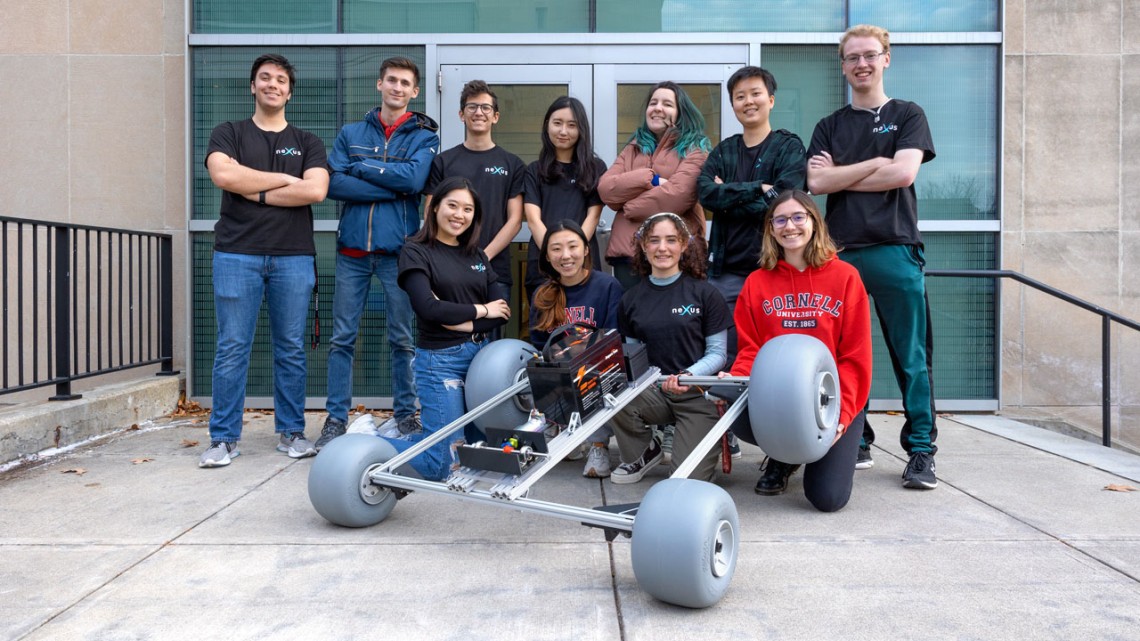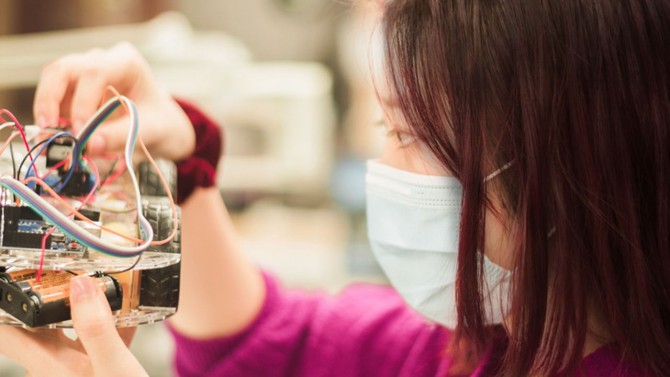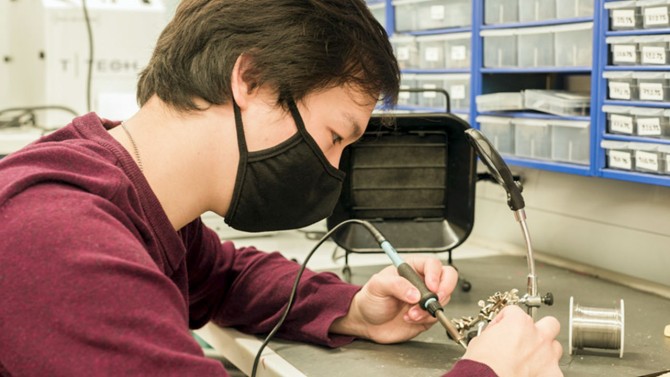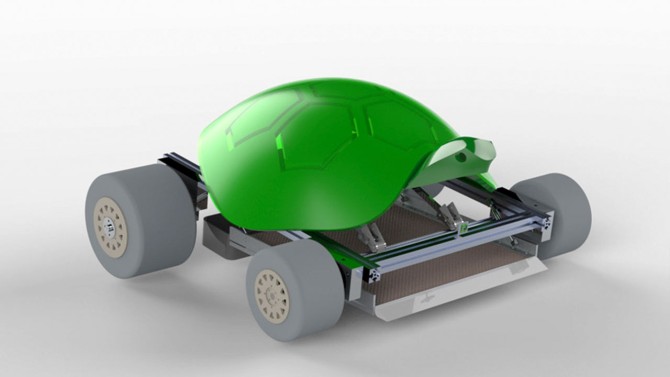
Cornell Nexus, a group of students from several colleges and majors, are designing and building an autonomous robot that will remove microplastics from the sand on beaches.
Students design robot to collect microplastics from beaches
By Linda Copman
When Angela Loh ’23 was 10 years old, she and her family moved to Shanghai from Michigan. She was immediately struck by how much more pollution she saw in Shanghai.
“When I stepped outside my home, the skies were grey and I could smell the stench of PM2.5 particles hanging in the air. I would walk on certain local streets and see litter everywhere,” she says. She noticed that most residents seemed complacent. “Nobody seemed to care.”
But Loh did care, deeply, about environmental sustainability.
As a freshman, Loh and Alan Hsiao ’21 founded Cornell Nexus, a group of students from diverse colleges and majors who are designing and building an autonomous robot that will remove microplastics from the sand on beaches. The team hopes to have a working land-based prototype built by spring 2023, when they will turn their attention to creating a submersible robot that will remove microplastics from sea water.
“We are a team of individuals who want to step outside the boundaries of university competitions to make a difference on our planet,” Loh says.
Microplastics, tiny bits of plastic the size of a sesame seed or smaller, are proliferating and pose a significant risk to ecosystems and to human and animal health. “There are 50 trillion pieces of microplastics embedded in our sand, our marine life, our oceans and even in our drinking water,” Loh says. A recent survey of the sea floor in the Mediterranean west of Italy found 1.9 million microplastics in one square meter. “This is just one layer of sand in a single square meter of the Mediterranean,” she says. “Imagine how much microplastic has accumulated in all of our bodies, our water and our land.”
Beach cleaning operations focus on removing the waste we can see, such as plastic water bottles and trash, often using gas-powered tractors that bury microplastics beneath the top layer of sand. In contrast, the Cornell Nexus robot will use renewable solar energy to collect and remove microplastic waste. “We believe that Nexus’ focus on autonomy and microplastics will revolutionize the technology for waste removal from beaches and bodies of water,” Loh says.
Planting the seed
Loh recalls making hand-drawn posters promoting recycling and distributing them to her neighbors when she was in elementary school. Moving to Shanghai – a city she loves – was a wake-up call. “I realized what big issues plastics, and pollution and waste in general, are on our planet,” she says, “and I really wanted to do something about them.”
In the summer after graduating from high school, Loh read a biography of Elon Musk and the founding of Tesla. “Reading this allowed me to realize the boundless possibilities there are in the field of engineering,” she says. Loh spent the next few months binge-reading biographies about inventors, entrepreneurs and engineers, from Steve Jobs to Leonardo da Vinci and Nike founder Phil Knight. She realized that engineering would be her springboard for creating change.
After perusing the College of Engineering website, Loh switched her major from environmental science to electrical and computer engineering and computer science. “Reading about the engineering project teams before I arrived at Cornell planted a seed in my brain that maybe one day it wouldn’t be impossible to start my own,” Loh says.
Alan Hsiao was a junior and one of the first people Loh met as a freshman at Cornell. “When we first started Nexus, I didn’t know anything – not even basic knowledge about programming or wiring circuit boards – let alone building an entire vehicle that was going to traverse beaches and charge itself,” Loh says. “Alan would spend hours and hours mentoring me and teaching me concepts that I hadn’t even heard of. … Through his kindness, wisdom and compassion, he has definitely left his impact on me, our Nexus team, the Cornell campus and our planet.”
Unleashing creativity, with help from alumni
Nexus team members are now building a prototype with a multilayered filtering system to catch a range of different sizes of microplastics. When full, the robot will return to its docking station to offload the collected plastics and recharge.
“Creating our robot requires knowledge about concepts and implementation mechanisms that are usually taught in graduate-level courses,” Loh says. Team members conduct their own in-depth research and seek out faculty who can guide their work. Joseph Skovira, Ph.D. ’90, senior lecturer in the School of Electrical and Computer Engineering and the group’s faculty adviser, is helping them refine their product.Greg Whelan ’83 of Greywale Advisors and part of the McCarthy’s Venture Mentoring Network has been helping them navigate business outreach and fundraising.
To ensure they have funding to purchase specialized hardware and software components, Nexus members have been developing relationships with companies that might sponsor the project once they have a prototype. In spring 2021, Nexus won first prize in the Cornell Engineering Innovation Competition. The Yunni and Maxine Pao Social Innovation Award, funded by Carolyn Wang ’00 and Jeff Pao ’00, allowed them to buy better wheels, a more robust material for the robot’s frame, filtration nets and more accurate sensors.
Doing the greatest good
Nexus is testing and refining their prototype in the 2022-2023 academic year, using a sand bed to test the robot’s moving, digging and filtering mechanisms. Then they will place their robot at several beaches, including some recommended by alumni from the Cornell Peter and Stephanie Nolan School of Hotel Administration.
Once the land-based robot is completed, the team hopes to launch their robot into the water, where the vast majority of microplastics are. “Our vision is to expand our technology to address the heart of the microplastics problem, which is underwater,” Loh says. “Very few commercial robots are tackling this issue, on a macro and micro scale.”
There are multiple design possibilities for a seafaring robot, including a water-based recharging and waste removal station, which could be more efficient than returning the robot to land.
The Nexus team plans to make their design freely available to the public. “This includes all of our software code, mechanical CAD files, electrical circuit board designs, and so forth,” Loh says. “Our goal is to make an impact and do our part to save our planet.”
Linda Copman is a writer for Alumni Affairs and Development.
Media Contact
Get Cornell news delivered right to your inbox.
Subscribe



